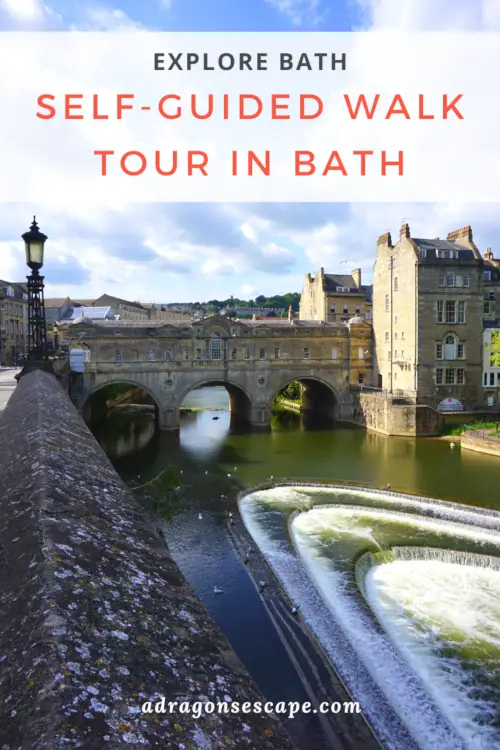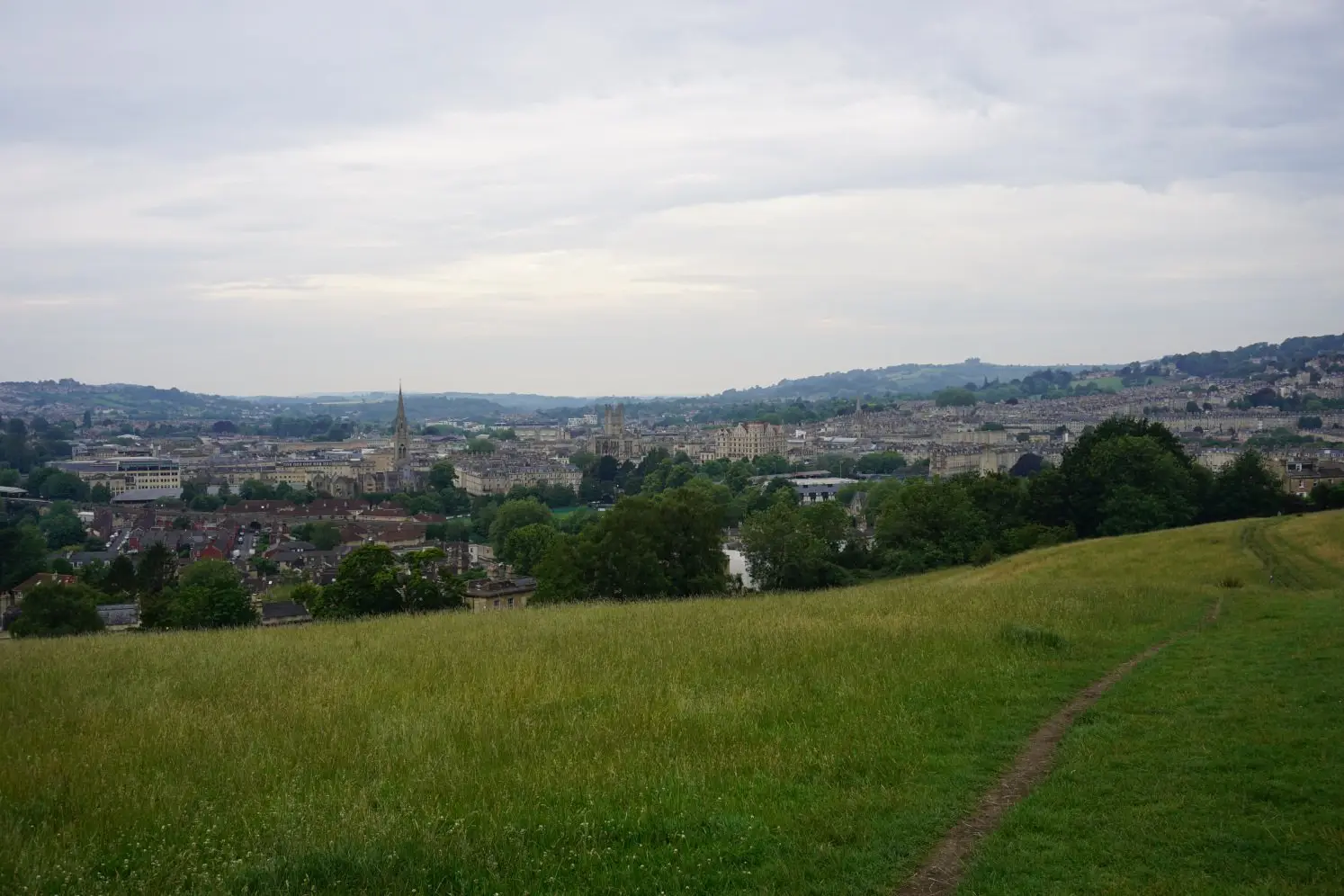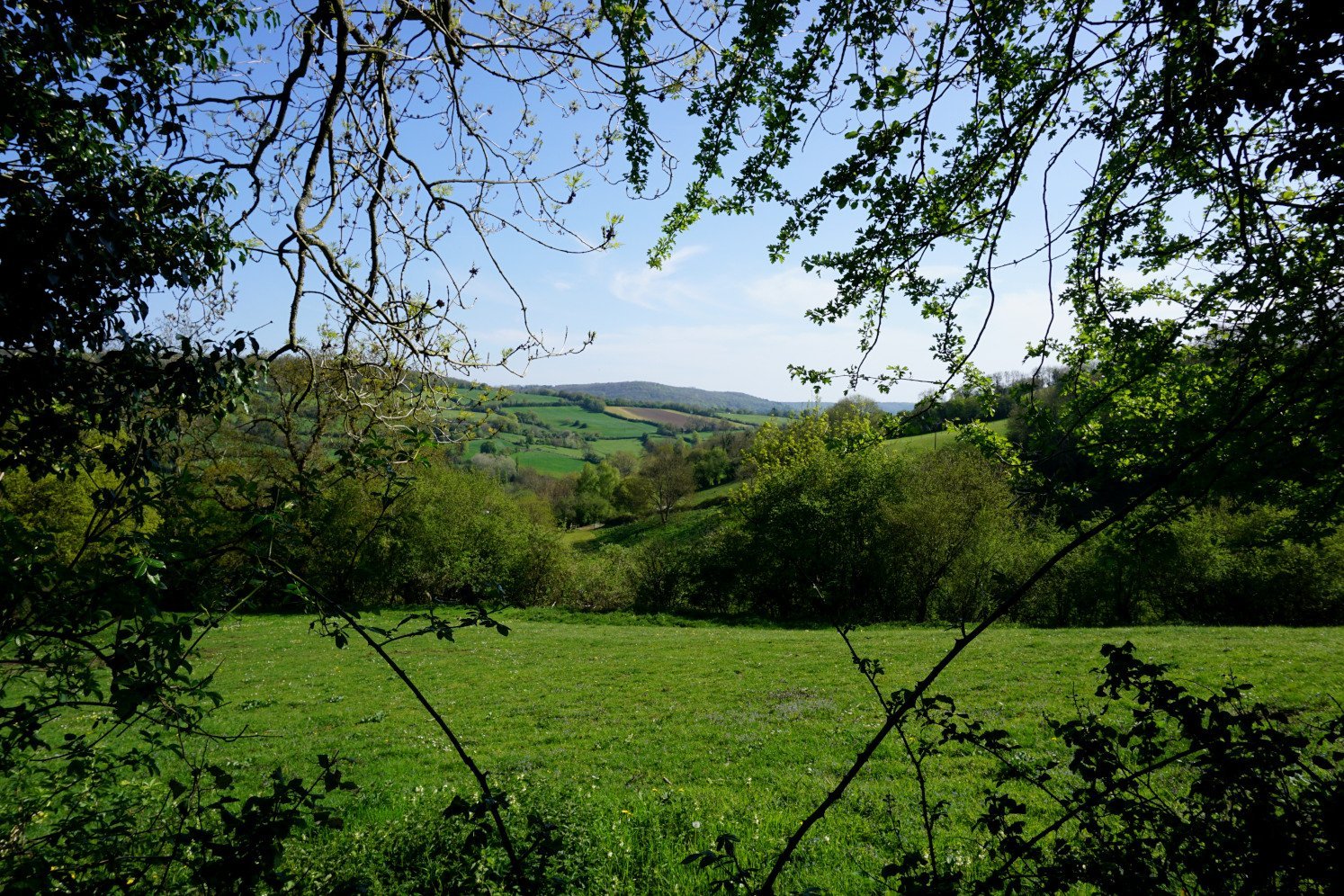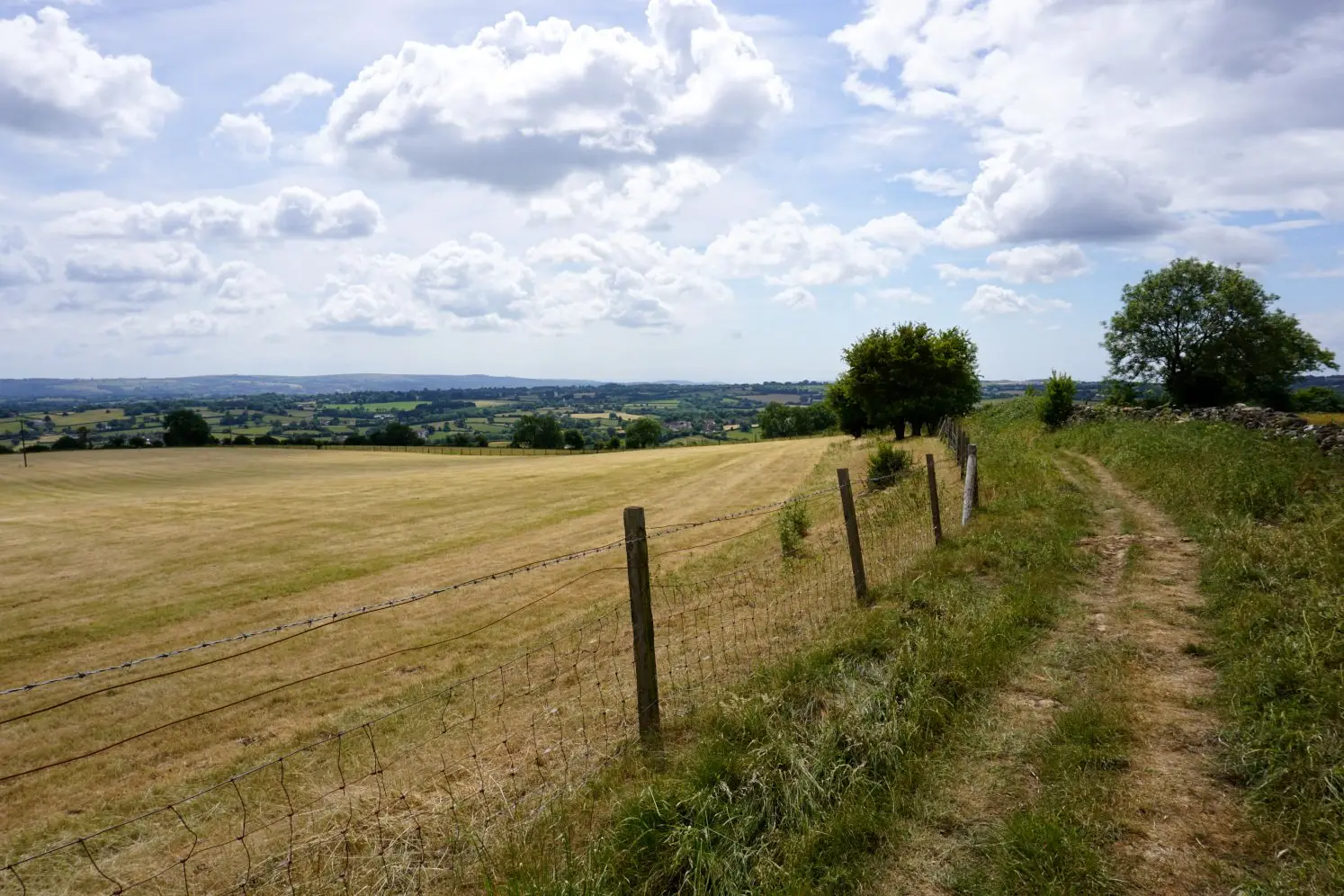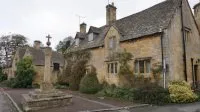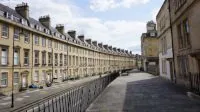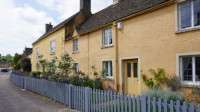One of the top travel destinations in the UK, the city of Bath offers an escape to magnificent Georgian architecture and beautiful Cotswold countryside. This self-guided walking tour explores the key sights and hidden gems in Bath. Walking along Bath’s streets, you’ll be awestruck by the Roman, medieval and especially Georgian influences that have shaped the spa city, and you’ll rapidly fall in love with this beautiful golden city.
This self-guided Bath walking tour takes 3 ½ to 4 ½ hours with limited stops. If you wish to visit any landmarks, such as the Roman Baths or Bath Abbey, this walking tour will take longer. If you’re short of time, you can cut this tour short and visit the first 11 sights only. You may also wish to complete this self-guided walk over 2 days and cut the tour in half at sight 11 – Pulteney Bridge to enjoy a more relaxing walk.
Location: Bath, Somerset
Walk difficulty: Intermediate
Time: 3 ½ to 4 ½ hours
Distance: 7 miles (11 km)
Why visit Bath
Known worldwide for its hot thermal springs, the city of Bath has attracted countless settlers across the centuries. From a charming Roman settlement to an enchanting Georgian hub, Bath has developed into the striking city it is today. The spa capital is located in South West England, just 20 minutes from Bristol and 1 ½ hours away from London.
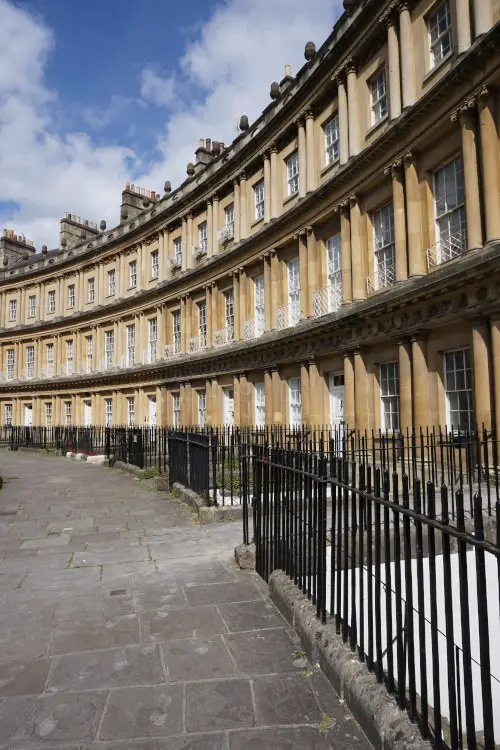
Crowned a UNESCO World Heritage Site, Bath offers Roman and medieval landmarks, magnificent Georgian architecture, striking golden limestone, and at its doorstep, the beautiful Cotswold countryside. From the arresting Royal Crescent to the imposing Bath Abbey and the serene Kennet & Avon Canal, Bath features countless splendid sights just waiting to be explored.
Bath walking tour itinerary
Contents:
1. Bath Abbey
2. The Roman Baths
3. Milsom Street
4. Queen Square
5. Royal Victoria Park
6. The Royal Crescent
7. The Circus
8. The Assembly Rooms
9. Lansdown Crescent (optional)
10. Walcot Village
11. Pulteney Bridge
12. Great Pulteney Street
13. Sydney Gardens
14. The Kennet & Avon Canal
15. Alexandra Park (optional)
16. SouthGate Shopping Centre (optional)
– How to get to Bath
– Where to stay in Bath
1. Bath Abbey
The Bath walking tour starts in the heart of the spa city at Bath Abbey. Built in the 16th and 17th centuries in Bath’s signature limestone, Bath Abbey has undergone many alterations since then. The abbey features arresting Gothic architecture, beautiful stained glass windows and a remarkable fan vaulted ceiling. Don’t forget to explore this iconic landmark from all sides; each will reveal a different facet of the abbey’s personality and history.
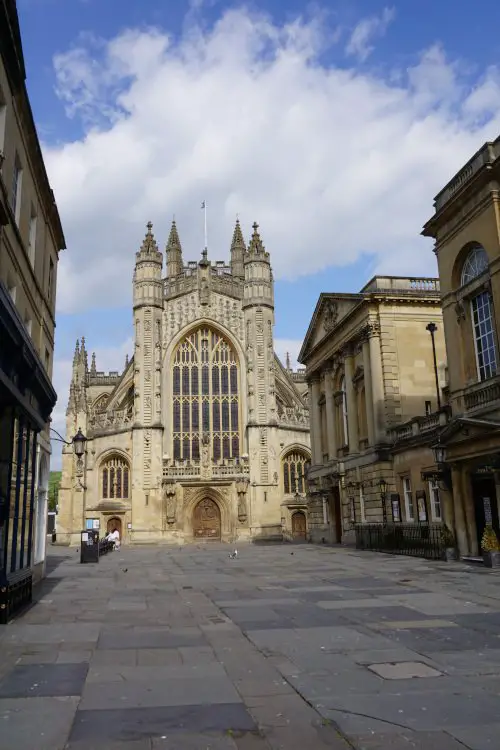
Top tip:
While visiting Bath Abbey, go on the Tower Tour. This tour takes you up the abbey’s narrow and spiral staircases to the rooftop for spectacular views over the city of Bath and the surrounding Cotswold countryside.
Walk instructions:
This self-guided walking tour starts at Bath Abbey (BA1 1LT). The entrance to the abbey can be found on Abbey Churchyard.
Find out more:
Bath Abbey invites visitors to make a small donation. For more information, visit bathabbey.org.
2. The Roman Baths
Located next to Bath Abbey, the Roman Baths were a natural thermal spa and date back to the Roman Empire. Over the centuries, this historic site has been visited by a multitude of people in search of the relaxing hot waters and medicinal properties of the thermal springs. The Roman Baths key attraction is the Great Bath, the biggest pool in the spa situated in an arresting column-lined courtyard.
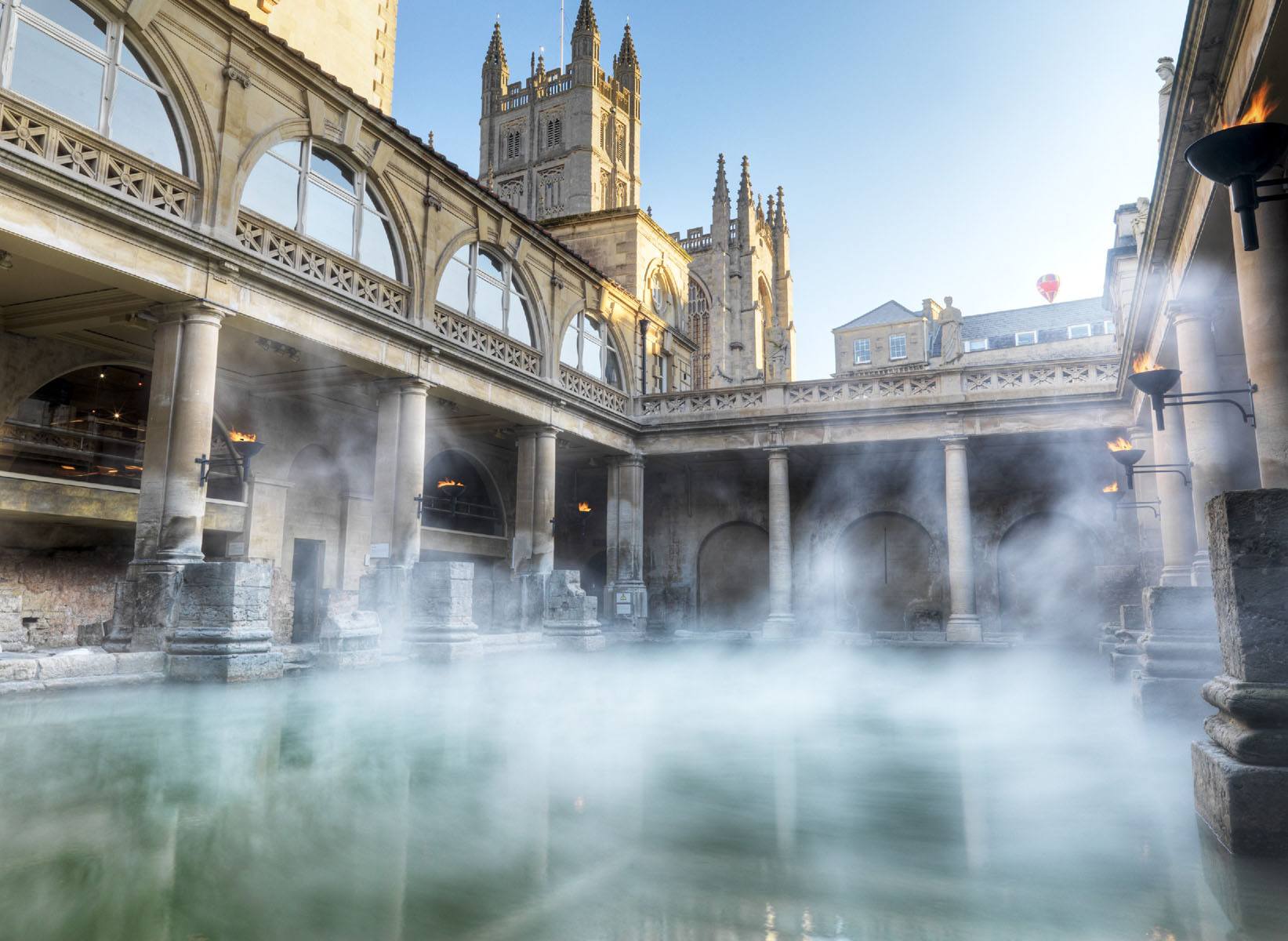
Top tip:
If you’re after the full Roman Baths experience, taste the hot tangy spa water at the water fountains in the West Bath or in the Pump Room. Back in the 18th century, the Georgians drank the water as a treatment for certain ailments.
Walk instructions:
The entrance to the Roman Baths can also be found on Abbey Churchyard.
Find out more:
You can visit the Roman Baths for a fee. However, you can no longer bathe in its spa waters. For more information, visit romanbaths.co.uk. If you wish to experience Bath’s thermal springs, you can visit Thermae Bath Spa.
3. Milsom Street
Milsom Street is a charming Georgian street lined with shops. Back in Georgian times, Milsom Street was the hub of the city and a fashionable shopping venue. This shopping street enjoys stunning Georgian architecture, intriguing stonework and lovely independent and high street shops with regal store fronts.
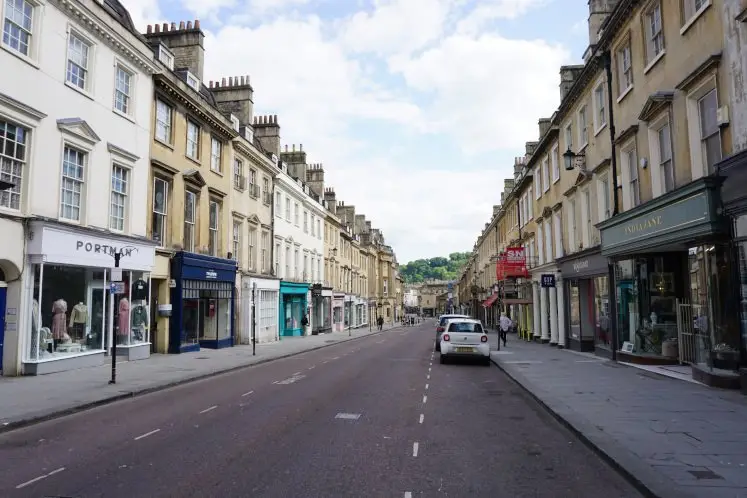
Top tip:
If you’re interested in quirky shopping streets, explore Union Passage, a narrow lane parallel to Union Street filled with delightful shops.
Walk instructions:
With your back to Bath Abbey, walk along Abbey Churchyard, turn right onto Stall Street and continue straight ahead to Milsom Street.
4. Queen Square
Featuring Georgian town houses built around a square, Queen Square is one of the most remarkable examples of Georgian architecture in Bath. The town houses on the northern side of the square resemble a palace and are the most impressive. Enclosed by black iron fencing, the square houses an 18th century obelisk and cherry trees.
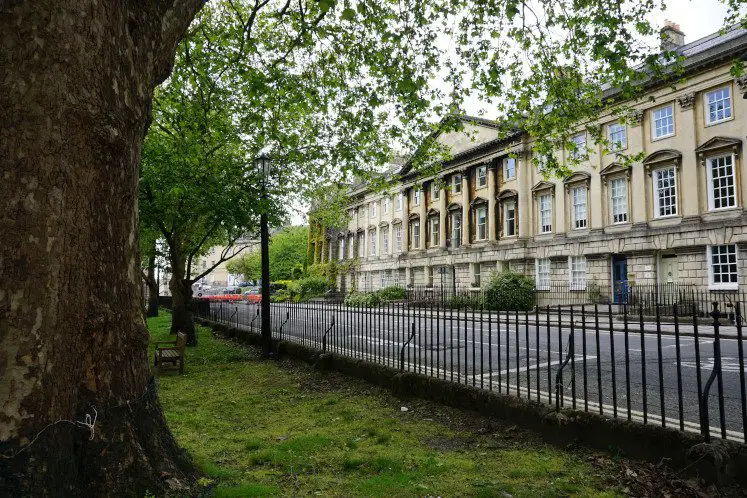
Top tip:
On her various trips to Bath, Jane Austen stayed in Queen Square in the late 18th century. The Jane Austen Centre is located a stone’s throw away on Gay Street. If you’re a fan of Jane Austen, visit the museum and discover more about the artist’s life, novels and stays in Bath.
Walk instructions:
At the bottom of Milsom Street, turn onto Quiet Street and at the end of this street, turn right, then immediately left onto Wood Street. At the end of Wood Street, you’ll reach the south eastern corner of Queen Square, the fourth stop of this Bath walking tour.
5. Royal Victoria Park
Opened in 1830, Royal Victoria Park is a large park named in honour of the then Princess Victoria. Located in the centre of Bath, the park is partly overlooked by the Royal Crescent. Royal Victoria Park boasts tree-lined avenues, an obelisk, picturesque park cottages, botanical gardens, duck ponds, a children’s playground, tennis courts, a mini golf, a skateboard park and a bowling green.
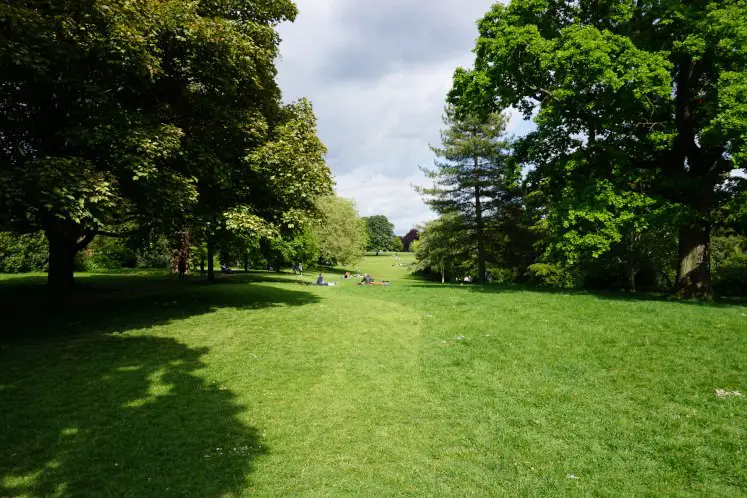
Top tip:
While in Royal Victoria Park, visit the Botanical Gardens. Featuring an array of colourful, unusual and delightful plants and trees, the Botanical Gardens date from the late 19th century and are one of Bath’s hidden gems.
Walk instructions:
At the opposite corner of Queen Square from Wood Street, take the side street, Queen’s Parade, and continue to Royal Avenue. The park starts here and enjoys lovely views of the Royal Crescent. However, the main parkland is further along. Continue along Royal Avenue, cross Marlborough Lane and go past the park fences.
6. The Royal Crescent
The Royal Crescent is one of the most iconic landmarks in Bath and one of the finest examples of Georgian architecture. A curved row of magnificent terraced houses in Bath’s signature limestone, the crescent is regally imposing and enjoys unobstructed views over Royal Victoria Park and the surrounding Cotswold hills and valleys.
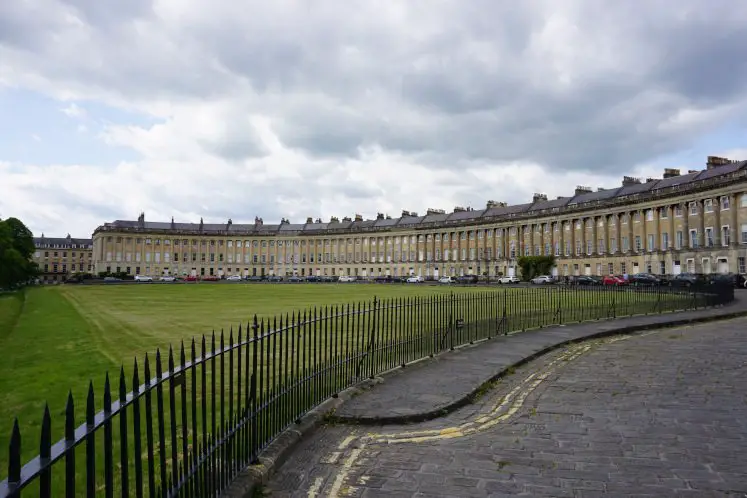
Top tip:
When visiting the Royal Crescent, take the time to discover the back of the curved row. While the front of the Crescent is perfectly symmetrical, the back is a mishmash of different shapes and styles and is beautiful in its imperfection.
Walk instructions:
After exploring the Royal Victoria Park, follow Royal Avenue back past the park fences and turn left onto Marlborough Buildings and right onto the Royal Crescent.
Find out more:
If you wish to explore life in a Georgian house, you can visit the museum at No. 1 Royal Crescent. For more information, visit no1royalcrescent.org.uk.
7. The Circus
The Circus is another remarkable example of Georgian architecture and forms a mesmerizing perfect circle of spectacular town houses in the golden Bath stone. The landmark was designed with the same diameter as Stonehenge and features three entrances and a green with a cluster of large imposing trees.
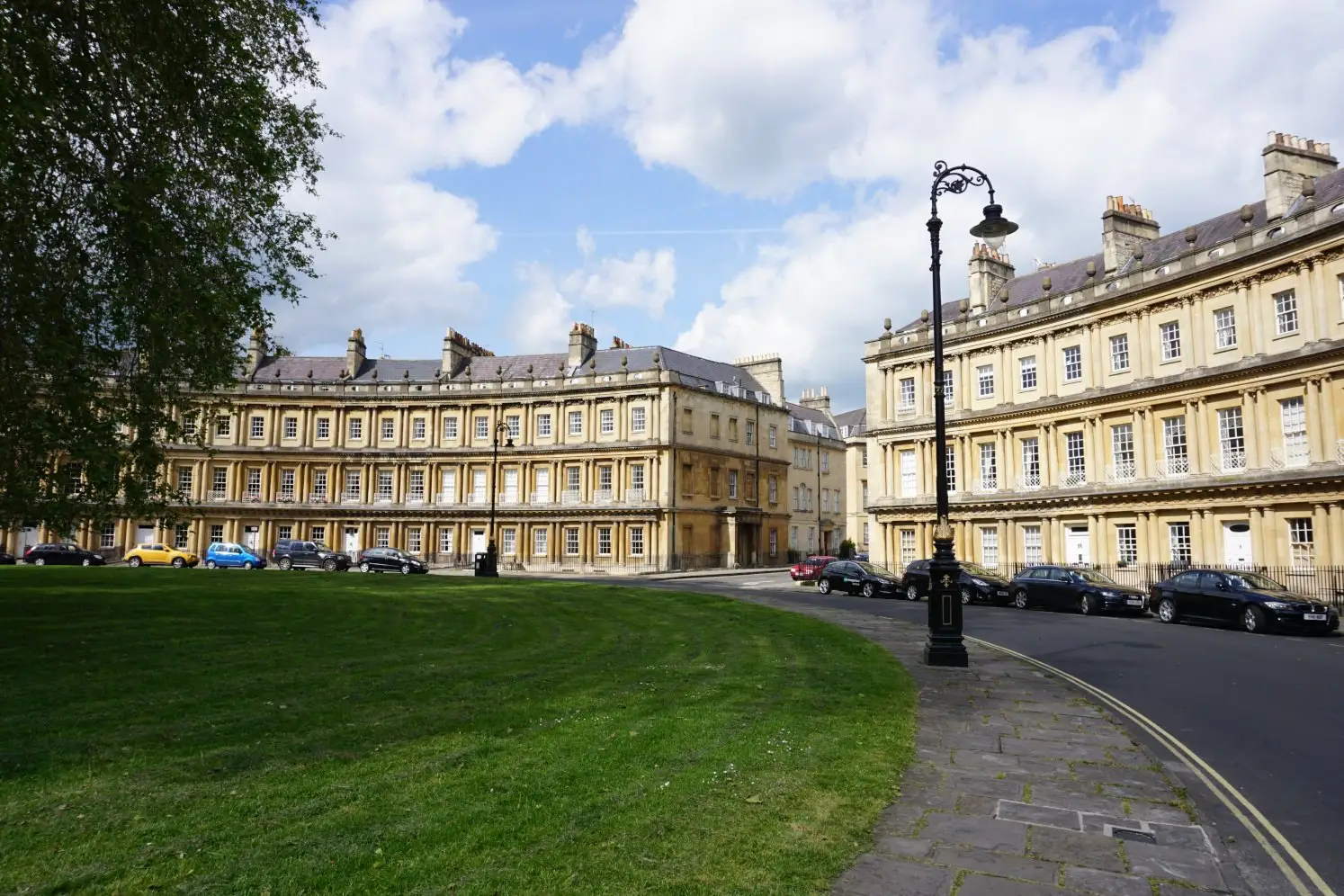
Top tip:
Don’t forget to admire the stonework on the façade of the town houses of the Circus. You’ll find decorative emblems, from acorns to serpents and other Masonic symbols.
Walk instructions:
From the Royal Crescent, follow the road onto Brock Street and to the Circus, the seventh stop of this Bath walking tour.
8. The Assembly Rooms
Located near the Royal Crescent and the top of Milsom Street, the Assembly Rooms are housed in another splendid Georgian building. Back in Georgian times, high society gathered at the Upper Rooms, as it was then known. They spent the evening ballroom dancing, listening to concerts or playing card games. These entertainments were held in four different and magnificent rooms, each purpose-built.
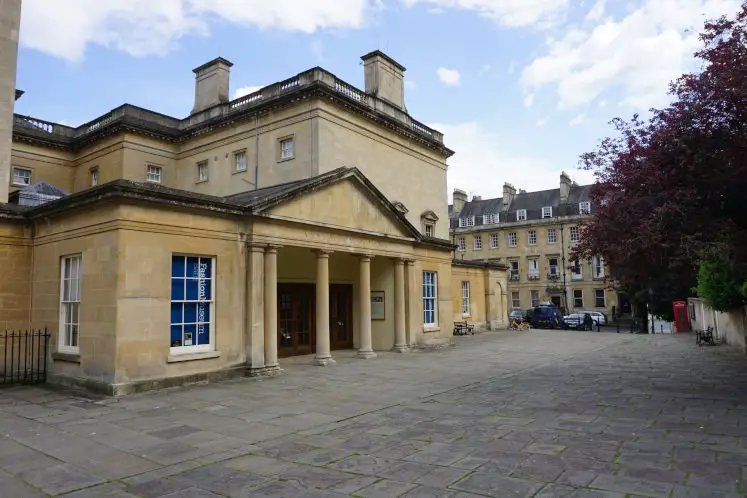
Top tip:
If you’re interested in fashion, visit the Fashion Museum. Housed in the Assembly Rooms, the museum exhibits an impressive collection of contemporary and historic dress.
Walk instructions:
From the Brock Street entrance to the Circus, veer left onto Bennett Street. You’ll find the Assembly Rooms on your right.
Find out more:
You can visit the Assembly Rooms for free, however, the Rooms are not always open. For more information, visit nationaltrust.org.uk.
9. Lansdown Crescent (optional)
Apart from the Royal Crescent, Bath also features six other crescent-shaped rows of terraced houses. Lansdown Crescent is the most impressive crescent after the Royal Crescent. Dating back to the late 18th century, Lansdown Crescent is located on Lansdown Hill and enjoys delightful communal gardens with lovely views of Bath.
This hidden gem is off the beaten path and up a steep hill, and so you may wish to skip this stop if you’re short of time.
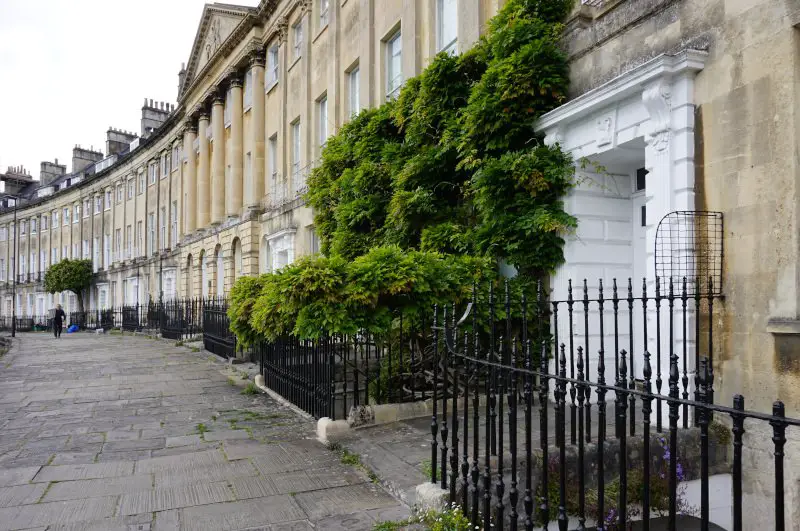
Top tip:
While in Lansdown Crescent, explore Somerset Place, Cavendish Crescent and Camden Crescent, another three Georgian crescents near Lansdown Crescent. Cavendish Crescent is the shortest and plainest crescent in Bath with only 11 houses and no embellishments. Camden Crescent suffered a landslide which destroyed some houses. As such, the central row of pillars is no longer in the middle of the crescent.
Walk instructions:
From the Assembly Rooms, continue along Bennett Street and turn left onto Lansdown Road. Walk up the steep hill, turn left onto Lansdown Place East (4th street on your left) and continue along the road to Lansdown Crescent.
To visit Somerset Place, continue past Lansdown Crescent and along Lansdown Place West, and turn right onto Somerset Place. For Cavendish Crescent, continue past Lansdown Crescent and along Lansdown Place West and Sion Hill, and turn left onto Cavendish Road then left again onto Cavendish Crescent. To visit Camden Crescent, go back down Lansdown Road and turn left onto Camden Crescent (2nd street on your left).
10. Walcot Village
Also known as the Artisan Quarter, Walcot Village is one of the best off-the-beaten-path places in Bath. Here, you can spend an afternoon browsing the exotic and remarkable antiques and independent shops. From antique furniture, silverware and jewellery to works of art, you’ll find astonishing items in Walcot Village.
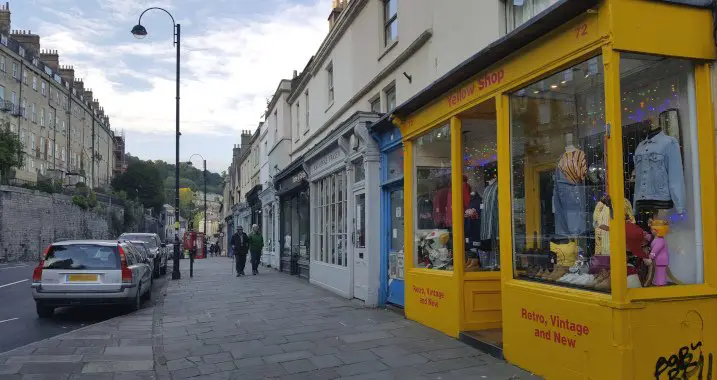
Top tip:
On your stroll along Walcot Street, spot the grotesque stone faces on the wall of The Paragon. The faces were carved in Bath’s signature limestone and represent mythical but also local characters.
Walk instructions:
From Lansdown Crescent, go back down Lansdown Road. [If you skipped Lansdown Crescent: From the Assembly Rooms, continue along Bennett Street and turn right onto Lansdown Road.] At the end of the Lansdown Road, turn left onto The Paragon. This is a small detour to explore The Paragon, an impressive curved street of Georgian town houses. At the roundabout, turn sharp right onto Walcot Street.
Find out more:
Please note that most antique shops are open from 10 a.m. to 5.30 p.m. and are closed on Sundays.
11. Pulteney Bridge
Pulteney Bridge is another key place to visit in Bath. This astonishing bridge is lined with charming small shops and is a delight to explore. Built in the 18th century, the iconic landmark crosses the River Avon and links the Pulteney area to the city centre. A key attraction of Pulteney Bridge is the distinctive horse-shoe shaped Pulteney Weir, where ducks enjoy swimming around.
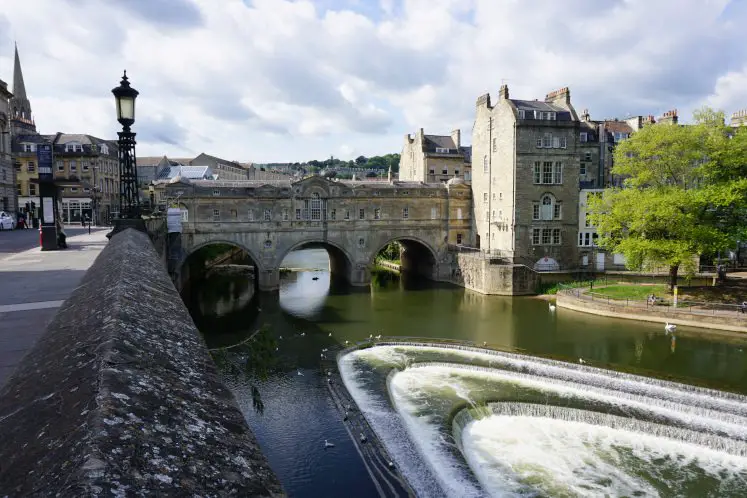
Top tip:
Enjoy the best view of Pulteney Bridge, Pulteney Weir and the city of Bath from Spring Gardens Road. To get there from the city centre, cross Pulteney Bridge and just after the bridge, take the flights of steps on your right. Go down the steps, along the river and you’ll end up on Spring Gardens Road.
Walk instructions:
Walk down Walcot Street, continue along Northgate Street and turn left onto Bridge Street. At the intersection, you’ll reach Pulteney Bridge, the 11th stop of this Bath walking tour.
12. Great Pulteney Street
Lined with imposing Georgian terraced houses, Great Pulteney Street is the widest street in Bath and one of the most impressive. Dating back to the late 18th century, Great Pulteney Street extends from Pulteney Bridge in the city centre to Sydney Gardens in Bathwick. At the start of Great Pulteney Street, Laura Place forms an interesting Georgian plaza with a fountain in the middle of the street.
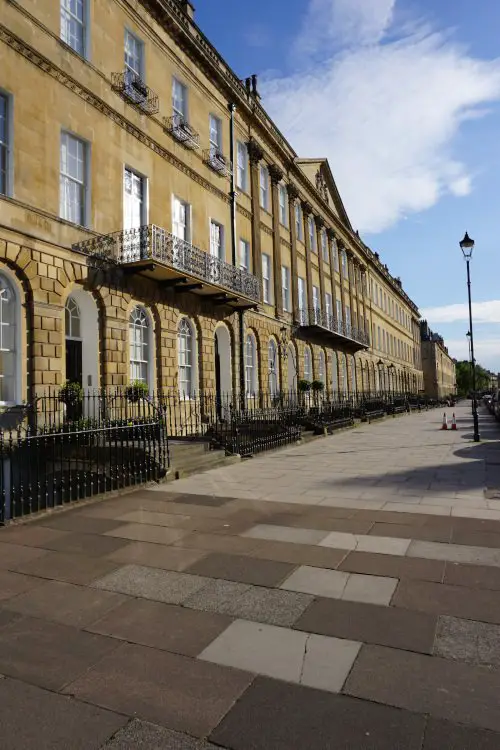
Top tip:
Along Great Pulteney Street, discover Sunderland Street, the shortest street in Bath with only one address and two front doors.
Walk instructions:
From Pulteney Bridge, continue straight ahead along Argyle Street and Great Pulteney Street.
13. Sydney Gardens
Reached from the city centre by Great Pulteney Street, Sydney Gardens is an 18th century pleasure garden and the oldest park in Bath. Popular in Georgian times, the park was a favourite with Jane Austen. Sydney Gardens boasts beautiful cast-iron bridges over the Kennet & Avon canal as well as a children’s playground and tennis courts.
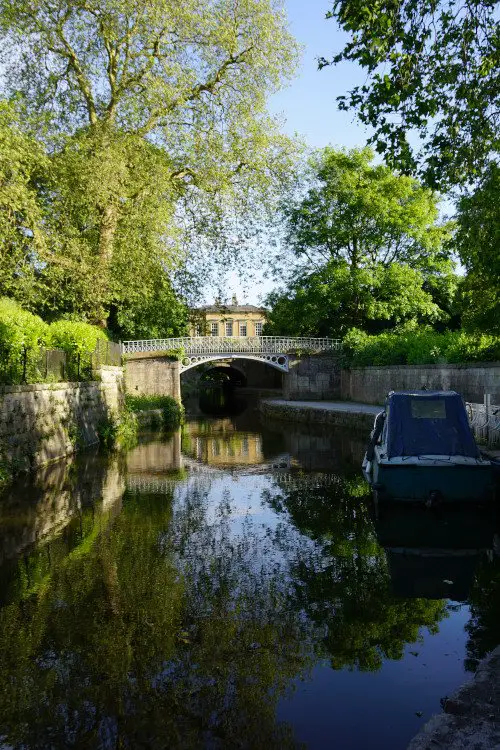
Top tip:
If you’re interested in art, visit the Holburne museum. Housed in Sydney Gardens, the art gallery was built around the collection of Sir Willian Holburne.
Walk instructions:
At the end of Great Pulteney Street, you’ll find the Holburne museum. From there, veer left and follow the edge of the park along Sydney Place to the entrance gate to the gardens.
14. The Kennet & Avon Canal
Built in the 18th and 19th centuries, the Kennet & Avon Canal runs through the city of Bath, including Sydney Gardens, as well as across the lovely Cotswold countryside. Walking along the peaceful canal, you can admire the stunning Georgian town houses lining the canal, the colourful narrowboats lazily cruising on the waters or moored to the banks, as well as the picturesque and intricate locks.
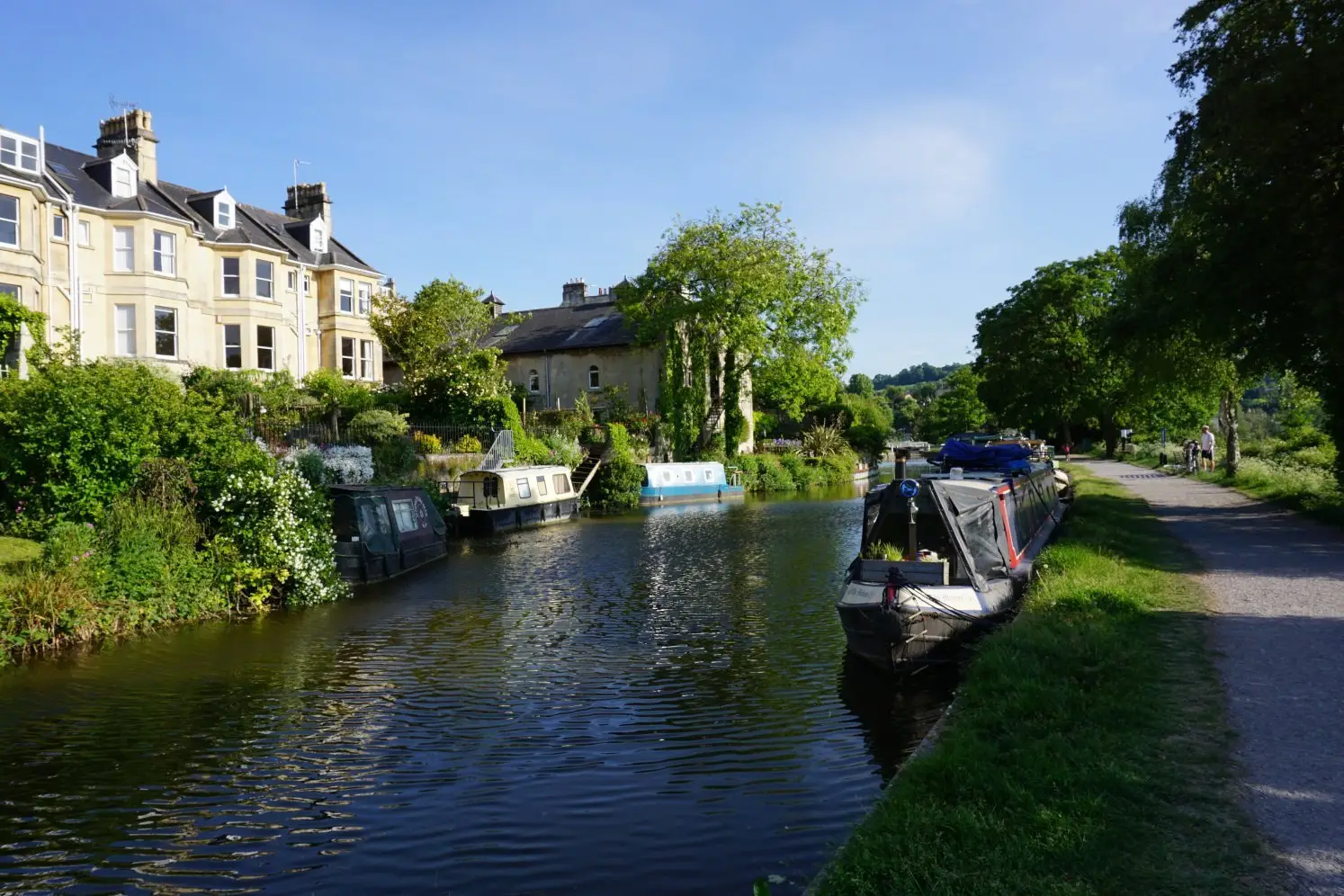
Top tip:
For a longer walk along the canal, stroll to Bathampton and beyond. In Bathampton, you can stop for refreshments at the George Inn before making your way back to Bath or continuing along the canal path to Bradford-on-Avon.
Walk instructions:
Turn left onto the wide central path starting at the Holburne museum, cross over the railway bridge and veer right towards a small intricate white gate leading to the canal. Turn right and walk along the canal path to Widcombe. Please note that at the intersection with Bathwick Hill, you’ll need to switch banks by walking back up to street level and crossing the road. Just follow the signposts.
15. Alexandra Park (optional)
Located at the top of Beechen Cliff hill, Alexandra Park overlooks the beautiful city of Bath. From the two panoramic viewpoints in the park, you can spot Bath’s famous landmarks, from Bath Abbey to the Royal Crescent. You can also admire the rows upon rows of Georgian terraced houses and enjoy striking views of the Kennet & Avon canal, the River Avon and the surrounding Cotswold Hills.
This hidden gem is off the beaten path and up a very steep hill, but the spectacular views of Bath are worth the climb.

Top tip:
Visit the delightful streets surrounding the park, including Shakespeare Avenue, Byron Road, Shelley Road and Kipling Avenue, and enjoy the charming architecture of the town houses.
Walk instructions:
At the intersection of the Kennet & Avon canal path with St Matthew’s Place, turn left onto the street and veer right onto Widcombe Parade and then Claverton Street. Turn left onto Lyncombe Hill, then right onto Calton Road. At the start of Calton Road, you’ll find an uphill path with steep steps, known as Jacob’s Ladder, that will take you to Alexandra Park and the north eastern viewpoint. Continue straight ahead along Alexandra Park to the north western viewpoint.
16. SouthGate Shopping Centre (optional)
SouthGate is an outdoor shopping centre in the heart of the city of Bath. Packed with high street shops and restaurants, SouthGate was rebuilt in 2009 in the iconic Bath stone and mimics the Georgian architecture of the spa city. Along with Milsom Street, Union Street and Stall Street, SouthGate is the best place for shopping in Bath.
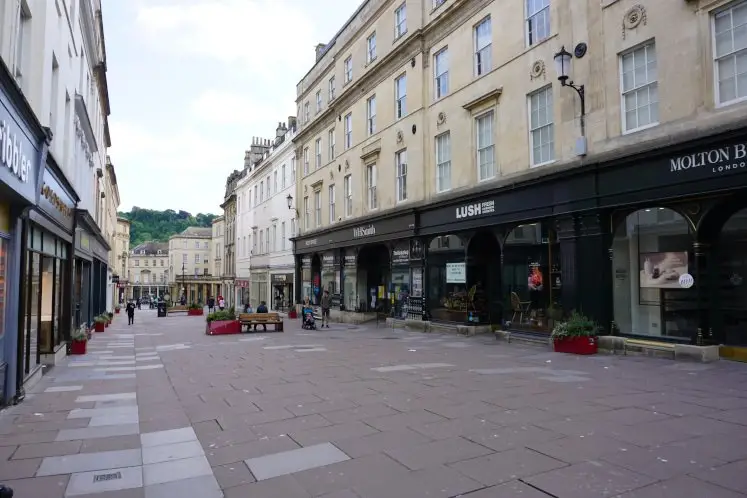
Walk instructions:
From the north western viewpoint in Alexandra Park, take the downhill path to the right of the town houses to Holloway Street. Turn right onto Holloway and at the bottom of the hill, veer left down a footpath towards the roundabout. [If you skipped Alexandra Park: At the intersection of the Kennet & Avon canal path with St Matthew’s Place, turn left onto the street and veer right onto Widcombe Parade and then Claverton Street.] Cross Claverton Street using the underpass, continue round the roundabout and cross the first bridge. Turn right onto Southgate Street, cross Dorchester Street and veer right along the pedestrian part of Southgate Street.
To finish this Bath walking tour at Bath Abbey, continue straight ahead along Southgate Street and then Stall Street, and turn right onto Abbey Churchyard.
Download the walk itinerary pdf: Bath walking tour by adragonsescape.com
Find the walk map and download the GPX file: Bath walking tour on outdooractive.com
How to get to Bath
By train
Arriving by train is usually the easiest way to get to Bath from any other UK city. Bath Spa is Bath’s main train station located in the heart of the city centre. There are direct trains to Bath from most South West cities, including London, Bristol, Cardiff and Exeter. If you’re arriving from other UK cities, such as Birmingham, Manchester or Edinburgh, you’ll need to change trains at Bristol.
By bus
Bus services to Bath are generally cheaper than trains. Again, there are direct buses to Bath from most South West cities, including London, Bristol and Exeter. Bus journeys tend to take longer than the train, and the British roads are notorious for roadworks and traffic which slow down the journey. The Bath Bus Station is located in the city centre next to the train station.

By car
Travelling by car to Bath is probably the option involving the most hassle, unless you’re arriving from a remote location with little public transport. You cannot rely on British roads for a speedy arrival, and Bath does tend to get congested, especially during rush hour.
You can park in Bath’s city centre in off-street car parks as well as on the streets. However, there is usually a time limit for on-street parking. You can park on the streets for free in the evenings and on Sundays. For more information about car parks in Bath, please visit bathnes.gov.uk.
By plane
The closest airport to Bath is Bristol airport and is well served by other major UK and European cities. The main airlines flying to Bristol include British Airways, EasyJet, KLM, Ryanair, Aer Lingus and Lufthansa. Bristol airport is located 45 minutes from Bath, and you can easily get into the city by bus or taxi.
For international or cheaper flights, London airports are your best bet. Prefer Gatwick and Heathrow as you can get to Bath more easily by train or bus. Cardiff and Birmingham are the other two airports closest to Bath, and again, you can travel to Bath by train or bus.
Where to stay in Bath
City centre
The city centre is the best place to stay in Bath when visiting. Along with the stunning Georgian architecture Bath is renowned for, most landmarks and places to explore are located in the city centre. The city centre also offers a myriad of cafés, restaurants, pubs and shops.
Bathwick
Originally a village, Bathwick was attached to the city of Bath via the iconic Pulteney Bridge in the 18th century. Located to the east of the River Avon, Bathwick features key sights, such as Great Pulteney Street, the Sydney Gardens and the Kennet & Avon Canal.
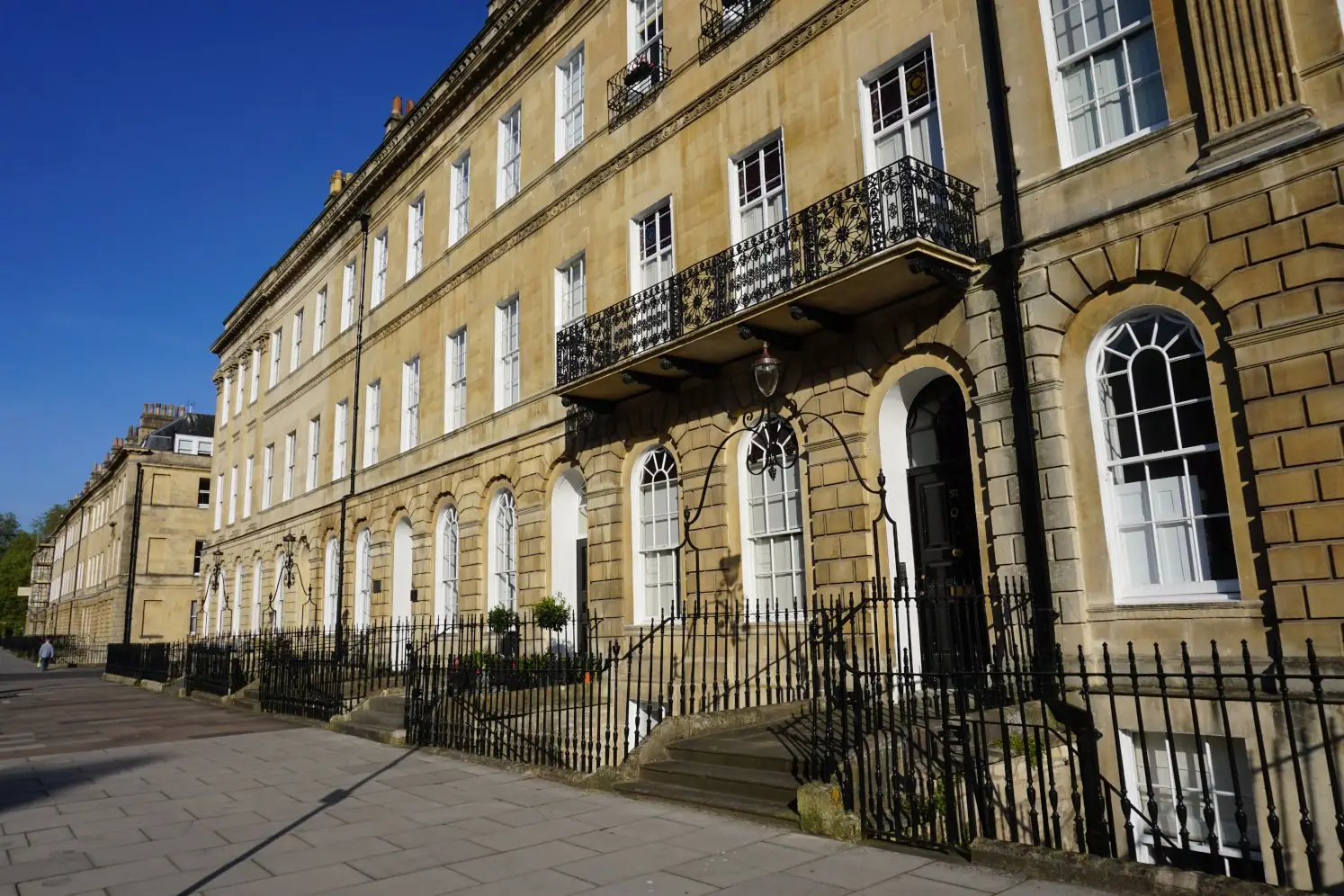
Walcot
Walcot Village is located north-east of the city centre and a short distance from Bath’s key landmarks. Also known as the Artisan Quarter, Walcot is well-known for its many antique and independent shops, and also enjoys gorgeous Georgian town houses.
Widcombe
Located south of the city centre and the River Avon, Widcombe offers a plethora of Georgian town houses and independent shops. A stone’s throw away from Bath’s main attractions, Widcombe enjoys a village feel and is close to the scenic gardens of Alexandra Park and Prior Park.
Lansdown
Lansdown is set on the side of a hill north of the city centre. While you can enjoy stunning views of Bath from Lansdown, you’ll first need to climb a steep hill. Key sights to visit in Lansdown include Lansdown Crescent, Somerset Place, Cavendish Crescent and Camden Crescent.
Explore Bath further
Alongside striking Georgian architecture, Bath boasts the enchanting Palladian bridge of Prior Park, the breathtaking Bath Skyline trail, beautiful Cotswold countryside and much more. Explore Bath further and find the top places to visit with the Bath guides.
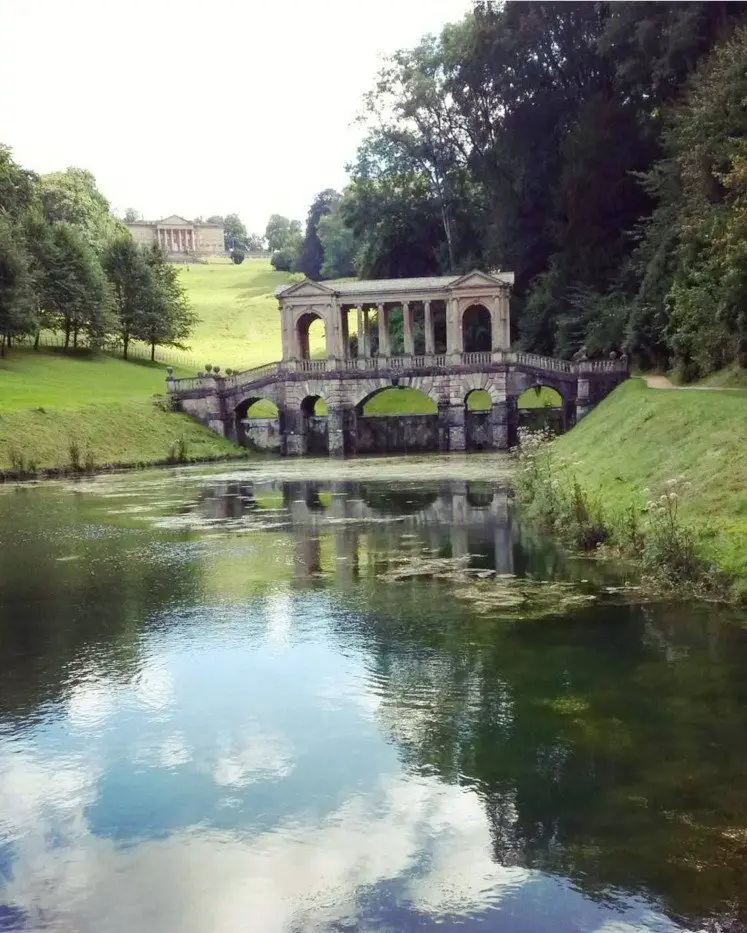
Share this guide:
Pin this for later:
